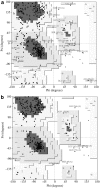Immunoinformatics Approach to Design a Novel Epitope-Based Oral Vaccine Against Helicobacter pylori
- PMID: 31120321
- PMCID: PMC6786345
- DOI: 10.1089/cmb.2019.0062
Immunoinformatics Approach to Design a Novel Epitope-Based Oral Vaccine Against Helicobacter pylori
Abstract
Helicobacter pylori is an infectious agent that colonizes the gastric mucosa of half of the population worldwide. This bacterium has been recognized as belonging to group 1 carcinogen by the World Health Organization for the role in development of gastritis, peptic ulcers, and cancer. Due to the increase in resistance to antibiotics used in the anti-H. pylori therapy, the development of an effective vaccine is an alternative of great interest, which remains a challenge. Therefore, a rational, strategic, and efficient vaccine design against H. pylori is necessary where the use of the most current bioinformatics tools could help achieve it. In this study, immunoinformatics approach was used to design a novel multiepitope oral vaccine against H. pylori. Our multiepitope vaccine is composed of cholera toxin subunit B (CTB) that is used as a mucosal adjuvant to enhance vaccine immunogenicity for oral immunization. CTB fused to 11 epitopes predicted of pathogenic (UreB170-189, VacA459-478, CagA1103-1122, GGT106-126, NapA30-44, and OipA211-230) and colonization (HpaA33-52, FlaA487-506, FecA437-456, BabA129-149, and SabA540-559) proteins from H. pylori. CKS9 peptide (CKSTHPLSC) targets epithelial microfold cells to enhance vaccine uptake from the gut barrier. All sequences were joined to each other by proper linkers. The vaccine was modeled and validated to achieve a high-quality three-dimensional structure. The vaccine design was evaluated as nonallergenic, antigenic, soluble, and with an appropriate molecular weight and isoelectric point. Our results suggest that our newly designed vaccine could serve as a promising anti-H. pylori vaccine candidate.
Keywords: Helicobacter pylori; in silico; multiepitope; oral vaccine; reverse vaccinology.
Conflict of interest statement
The authors declare there are no competing financial interests.
Figures









References
-
- Burucoa C., and Axon A. 2017. Epidemiology of Helicobacter pylori infection. Helicobacter. 22, e12403 - PubMed
Publication types
MeSH terms
Substances
LinkOut - more resources
Full Text Sources
Other Literature Sources
Medical
Miscellaneous
